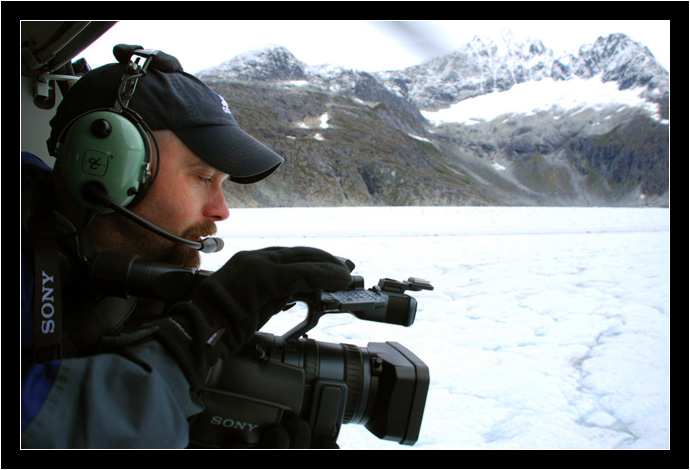High Definition SEAMONSTERs

Sometimes I really love my job.
At the end of September, on what would otherwise have been just another Friday, I got to tag along on a free helicopter ride up into the Juneau icefield.
It was the end of the tourist season and most of the local heli-tour companies were shutting down. The sun was out, the weather cooperating, and there was just time enough for one more data collection run.
Matt Heavner, one of our Environmental Science professors here at UAS, was working on a remote networking project called SEAMONSTER. One of his students, Logan, was taking pictures for use in Microsoft’s Photosynth project (Logan also gets credit for the photos posted here.) Another student and faculty member filled out their team, but even so, there was still one seat left. Would Media Services like to send someone along to document the afternoon?
Duh.
Normally, I’m low man on the totem pole for video assignments. We have at least two other staff that shoot and edit on a day-to-day basis and are more qualified to capture video. (Most of my video work is in the authoring of DVDs or converting their video to online formats.) But on that Friday they were busy getting ready for a live evening broadcast. Me? Free as a bird and just looking for an excuse to test out the new HDV equipment.
Northstar Trekking was the helicopter service of choice; Matt’s grant money paid the charter. We spent quite a bit of time on the ground, waiting for them to send the tourists from the last cruise ship of the season packing. It turns out we had booked the last flight of 2007.
The ride up to the icefield was majestic. The sun was shining; Thunder Mountain and the Mendenhall valley were in full autumn colors. Once we progressed beyond the mountain peaks, the landscape turned decidedly monochromatic.
Matt had his hand-held GPS unit and we used it to locate small markers that they’d placed on the ice months before. The markers, foot-tall pyramids made of wire and orange engineer’s tape, were incredibly hard to spot! Even hovering close to the GPS-indicated coordinates, we sometimes had to land and walk around before finding them.
On the ground, there was very little time to set up the camera. Matt and his team were very familiar with their duties and collected their data quickly. Even though the cold and wind made it difficult to keep a handheld camera steady, taking the tripod out of the storage compartment often took too much time.
Our pilot was awesome. Besides being happy to accommodate Matt’s wishes for multiple passes and landings, looking for those elusive markers, he was aware that I had different goals. At one point, he asked me over the on-board headsets, “How Hollywood do you want to get here?”
At the next landing site, he briefed me with instructions on how to open and secure the door. When we located the next marker, I situated myself sidesaddle, slid open the door, and hung half out of the helicopter. The tiny marker was swallowed up by such a huge landscape of ice… “Could you land, let everyone off, and take me back up for some aerial shots?” I asked.

No problem.
I was even able to stage some shots of people getting in and out of the helicopter, blades slashing the air above them. Then we went back up, just the pilot and I, so we could circle around everyone as they approached the marker on the ground. With the motion of the helicopter and the wind chill of an open door, it was impossible to keep the camera steady. There’s no confusing it with National Geographic, but it was still pretty cool.

There wasn’t any sort of plan for the hour-and-twenty-minutes of footage I shot. Eventually, I’d like to edit it into some sort of marketing piece for Matt – or at the very least, something to submit with his grant report – but before I can do that, I’d have set up an interview or voiceover session with him.
In the meantime, I at least had some HDV to experiment with (finally!) Premiere Pro captured it easily enough – the only delay was when it automatically converted to Cineform’s intermediary format. The resolution came in at a tasty 1440×1080, which stretches to a widescreen “full” HD 1920×1080 image, but still quite a bit better than the old 640×480 NTSC video I’m used to working with. 1,555,200 vs. 307,200 pixels. That’s more than five times the quality!
If this is the old 640×360 widescreen format:

Then this is the new 1920×1080 widescreen format:

It was interesting to play with post-production stabilizing filters. Some aerial footage smoothed out beautifully (check the last scene), but some wouldn’t improve no matter what I tried (the disappointingly shaky footage of Suicide Falls in the middle).
I didn’t spend more than an hour or two editing. I wasn’t looking to make a big production out of this, just a short piece to see how the HD workflow progresses from acquisition to distribution. What do you need for a minute-long editing experiment? Music. I needed to find a short piece of music to edit to. I like to think that most people in my position would have come up with the same soundtrack.
I can’t even embed the video here, because it’s too wide for this blog’s single column. If you’d like to take a look, you’ll have to download it:
(SEAMONSTER-HD – 40 MB Windows Media file)
